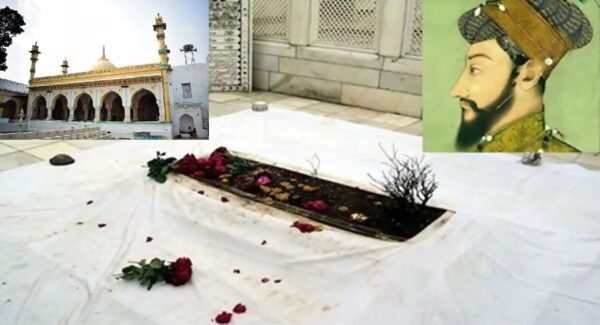All About Disputed Aurangzeb Tomb in Khuldabad, Aurangabad Now Chhatrapati Sambhaji Nagar, Maharashtra, India

The tomb of Mughal Emperor Aurangzeb, located in Khuldabad, a small town approximately 24 kilometers from Chhatrapati Sambhaji Nagar (formerly Aurangabad) in Maharashtra, India, has long been a site of historical significance and, more recently, intense controversy. Aurangzeb, the sixth Mughal emperor who ruled from 1658 to 1707, is a polarizing figure in Indian history due to his complex legacy, which includes both his administrative achievements and his conflicts with regional powers, notably the Marathas. His simple grave in Khuldabad, situated within the courtyard of the shrine of his spiritual guide, Sheikh Zainuddin Shirazi, reflects his expressed desire for modesty in death—a stark contrast to the grand mausoleums of his predecessors like the Taj Mahal. However, this unassuming tomb has become a flashpoint for political and communal tensions in contemporary India, particularly in Maharashtra.
Aurangzeb died in 1707 in Ahmednagar (now Ahilyanagar), about 130 kilometers from Khuldabad, after nearly five decades of rule—the longest of any Mughal emperor. Unlike his forebears, who were buried in elaborate tombs in Delhi or Agra, Aurangzeb chose a modest burial near his Sufi mentor in Khuldabad, a town already revered as a center of Chishti Sufism known as the “Valley of Saints.” His will reportedly instructed that his burial cost no more than 14 rupees and 12 annas, earned from stitching caps, and that his grave remain open to the sky, covered only by earth with a basil plant. This simplicity was later altered when the Nizam of Hyderabad and British Viceroy Lord Curzon added a marble screen and platform in the 19th and early 20th centuries, respectively. The town’s name, Khuldabad, meaning “Abode of Eternity,” evolved from its earlier name, Rauza, and was cemented after Aurangzeb’s burial, reflecting his posthumous title “Khuld-makani” (Resident of Paradise).
Historically, Khuldabad’s significance predates Aurangzeb. It became a spiritual hub in the 14th century when Sufi saints migrated there following the Delhi Sultanate’s shift of capital to Daulatabad under Muhammad bin Tughluq. Mughal patronage, particularly under Aurangzeb, who made Aurangabad his Deccan capital, further elevated its status. After his death, the town continued to be a burial site for Mughal and later Nizam nobility, including Asaf Jah I, the first Nizam of Hyderabad.
The tomb’s current controversy stems from Aurangzeb’s fraught legacy in Maharashtra, where he is vilified for his prolonged military campaigns against the Marathas and the brutal execution of Chhatrapati Sambhaji, the son of Maratha icon Chhatrapati Shivaji Maharaj, in 1689. Sambhaji’s torture and death have made him a martyr in Maratha lore, and Aurangzeb’s tomb, located in a region renamed Chhatrapati Sambhaji Nagar in 2022 to honor Sambhaji, is seen by some as an affront to this legacy.
The dispute gained momentum in recent years, fueled by political rhetoric and cultural narratives. In May 2022, a visit by AIMIM leader Akbaruddin Owaisi to the tomb sparked outrage among Maratha and Hindu nationalist groups, prompting the Archaeological Survey of India (ASI) to temporarily close the site amid fears of vandalism. The release of the 2025 Bollywood film Chhaava, depicting Sambhaji’s resistance against Aurangzeb, further inflamed sentiments. Samajwadi Party MLA Abu Azmi’s subsequent defense of Aurangzeb, claiming he was not a cruel ruler and had built temples, triggered a fierce backlash from the ruling Mahayuti coalition (comprising the BJP and Shiv Sena) and right-wing outfits like the Vishwa Hindu Parishad (VHP) and Bajrang Dal.
By March 2025, demands for the tomb’s demolition intensified. BJP MP Udayanraje Bhosale, a descendant of Shivaji, publicly called for its razing, labeling Aurangzeb a “thief” and questioning its relevance. Maharashtra Chief Minister Devendra Fadnavis echoed this sentiment, stating on March 8, 2025, that “everyone feels the grave should be removed,” though he emphasized that any action must comply with legal processes due to its status as an ASI-protected monument. Hindu groups escalated the rhetoric, with Bajrang Dal threatening a “Babri-like fate” if their demands were unmet, referencing the 1992 demolition of the Babri Masjid. Protests in Nagpur on March 17, 2025, turned violent, injuring over 30 people and prompting a curfew, highlighting the issue’s volatility.
The tomb, designated a “monument of national importance” by the ASI, remains under legal protection, complicating calls for its removal. Following the Nagpur clashes, security was significantly tightened around the site in Khuldabad. As of March 18, 2025, police, State Reserve Police Force (SRPF), and Home Guard personnel are deployed, with barricades and mandatory visitor registration in place. The caretaker, Parvez Kabeer Ahmed, reported a sharp decline in visitors—from a pre-controversy average of 2,500–3,000 daily to just 200–400—attributing it to the unrest and seasonal factors like Ramadan.
Local businesses, such as flower shops near the tomb, have also suffered, with owners like Sheikh Arbaz noting a 50% drop in trade. Despite the tension, Khuldabad’s residents, who have historically coexisted peacefully across religious lines, express a desire for calm. The ASI maintains six staff members for the tomb’s upkeep, underscoring its commitment to preservation, though it does not track footfall as it is not a ticketed site.
The dispute reflects broader ideological divides. Hindu nationalists and Maratha pride advocates view the tomb as a symbol of oppression, with leaders like Fadnavis linking it to historical grievances amplified by Chhaava. Conversely, figures like Shiv Sena (UBT) MP Sanjay Raut argue it should remain as a testament to Maratha resilience, while Prakash Ambedkar’s 2023 visit to offer tributes framed it as a neutral historical site. Critics, including some Muslim leaders, accuse the BJP of exploiting the issue for political gain, noting Aurangzeb’s obscurity in public discourse until recent communal polarization.
Aurangzeb’s tomb in Khuldabad stands at the intersection of history, religion, and politics. Its modest design belies the outsized emotions it evokes in 2025 Maharashtra, where past conflicts are rekindled through modern lenses. While legally safeguarded for now, its future remains uncertain amid rising calls for demolition, testing the balance between historical preservation and contemporary sentiment in a region shaped by both Mughal and Maratha legacies.
The Tomb of Aurangzeb is located in Khuldabad, Maharashtra, India. Aurangzeb, the sixth Mughal emperor, ruled most of the Indian subcontinent from 1658 until his death in 1707. Unlike other grand Mughal mausoleums, Aurangzeb’s tomb is notably simple, reflecting his personal wishes for austerity. He was interred in an unmarked grave within the complex of the dargah (shrine) of Sheikh Zainuddin, a Sufi saint who was his spiritual mentor.
Recently, the tomb has become a focal point of controversy. Hindu nationalist groups, such as the Bajrang Dal and Vishwa Hindu Parishad (VHP), have demanded its removal, labeling Aurangzeb a “thief” and “looter” due to his historical actions against Hindus. These groups have threatened that if the government does not act, the tomb could face a fate similar to the Babri Masjid, a mosque demolished by Hindu extremists in 1992.
The situation escalated into violence in Nagpur, Maharashtra, where clashes between Hindu and Muslim communities resulted in injuries and property damage. Authorities imposed an indefinite curfew in response to the unrest.
Security measures around the tomb have been heightened to prevent potential vandalism or destruction.
This controversy is part of a broader effort by some Hindu nationalist factions to reinterpret India’s history, often targeting symbols of the Mughal era. Critics argue that such actions are divisive and distract from pressing socio-economic issues.
The situation remains tense, with ongoing debates about historical legacy, cultural preservation, and religious tensions in contemporary India.
The tomb of Mughal Emperor Aurangzeb, located in Khuldabad (now Chhatrapati Sambhaji Nagar), Maharashtra, has become a focal point of controversy and political debate in recent years. This site, which holds significant historical and cultural value, is protected under the Archaeological Survey of India (ASI) due to its architectural and historical significance.
Aurangzeb, who ruled from 1658 to 1707, was the sixth Mughal emperor and is often regarded as one of the most contentious figures in Indian history. His reign marked the peak of the Mughal Empire, but it was also characterized by conflicts with various regional powers, particularly the Marathas. He died in Ahmednagar and was buried in Khuldabad as per his last wishes, near the shrine of his spiritual guide, Sheikh Zainuddin.
The tomb itself is a modest structure, reflecting Aurangzeb’s personal preference for simplicity over grandeur. It follows the Chishti Sufi tradition in its architectural style, which is less ornate compared to other Mughal mausoleums. The site has been recognized for its cultural importance and is part of a larger complex that includes other historical figures’ tombs.
In recent months, calls for the demolition of Aurangzeb’s tomb have intensified, primarily driven by right-wing groups such as the Vishwa Hindu Parishad (VHP) and Bajrang Dal. These groups argue that Aurangzeb’s legacy is one of tyranny and oppression against Hindus, particularly citing his execution of Chhatrapati Sambhaji Maharaj and the destruction of temples. The release of a Marathi film titled Chhaava, depicting Sambhaji’s life, has further fueled these sentiments and led to protests across Maharashtra.
Protests have escalated into violence in some areas, particularly in Nagpur, where clashes broke out recently. The local government has since imposed prohibitory orders and increased security around the tomb to prevent further unrest. Chief Minister Devendra Fadnavis has acknowledged public sentiment regarding the tomb but emphasized that any action must comply with legal frameworks due to its ASI-protected status.
The ongoing controversy has significantly affected visitor numbers to Aurangzeb’s tomb. Reports indicate a drastic decline in foot traffic—from approximately 2,500-3,000 daily visitors to just 200-400—amidst fears of violence and vandalism. The caretaker of the site noted that while the situation remains peaceful currently, public interest has waned due to the surrounding tensions.
The tomb of Aurangzeb stands as a symbol of India’s complex historical narrative. While it is protected as a monument of cultural heritage, it also embodies ongoing ideological battles about history and identity in contemporary India. The future of this site remains uncertain as political pressures mount and public sentiments continue to evolve.
औरंगाबाद (अब छत्रपति संभाजीनगर), महाराष्ट्र, भारत के खुलदाबाद में विवादित औरंगजेब का मकबरा:
औरंगजेब का मकबरा, जो अब छत्रपति संभाजीनगर, महाराष्ट्र में स्थित है, एक विवादित स्थल रहा है। यहां मकबरे के बारे में कुछ जानकारी दी गई है:
स्थान: मकबरा खुलदाबाद शहर में स्थित है, जो औरंगाबाद (अब छत्रपति संभाजीनगर) से लगभग 24 किलोमीटर दूर है। यह शेख़ ज़ैनुद्दीन शिराज़ी की दरगाह परिसर के दक्षिण-पूर्वी कोने में स्थित है।
इतिहास: औरंगजेब की मृत्यु 3 मार्च 1707 को अहमदनगर (अब अहिल्यानगर) में हुई थी। उनकी इच्छा के अनुसार, उन्हें खुलदाबाद में दफनाया गया। मकबरा सादा है, जो औरंगजेब की सादगी को दर्शाता है।
विवाद: मकबरा हाल के वर्षों में विवाद का विषय रहा है। कुछ राजनीतिक और सामाजिक संगठनों ने मकबरे को हटाने या बंद करने की मांग की है, जबकि अन्य ने इसे ऐतिहासिक स्थल के रूप में संरक्षित करने की वकालत की है।
मई 2022 में, एआईएमआईएम नेता अकबरुद्दीन ओवैसी द्वारा मकबरे पर जाने के बाद मकबरा खबरों में आया। इसके बाद, महाराष्ट्र नवनिर्माण सेना (मनसे) ने मकबरे को “नष्ट” करने की धमकी दी, जिसके बाद पुलिस ने साइट पर सुरक्षा बढ़ा दी।
हाल ही में, महाराष्ट्र के उपमुख्यमंत्री देवेंद्र फडणवीस ने कहा कि औरंगजेब के मकबरे का प्रबंधन करने वाले ट्रस्टियों को यह सुनिश्चित करना चाहिए कि स्थल पर कोई “ओरंगजेब का गुणगान” न करे।
महत्व: मकबरा ऐतिहासिक और सांस्कृतिक महत्व का स्थल है। यह मुगल सम्राट औरंगजेब के जीवन और विरासत की याद दिलाता है।
वास्तुशिल्प: औरंगजेब का मकबरा मुगल वास्तुकला की सादगी का एक उल्लेखनीय उदाहरण है। यह अन्य मुगल सम्राटों के भव्य मकबरों के विपरीत है। मकबरे में एक साधारण कब्र है, जो एक संगमरमर की जाली से घिरी हुई है।
पहुंच: मकबरा खुलदाबाद शहर में स्थित है, जो औरंगाबाद (अब छत्रपति संभाजीनगर) से सड़क मार्ग द्वारा आसानी से पहुँचा जा सकता है।
यह ध्यान रखना महत्वपूर्ण है कि मकबरे पर विवाद जारी है।

